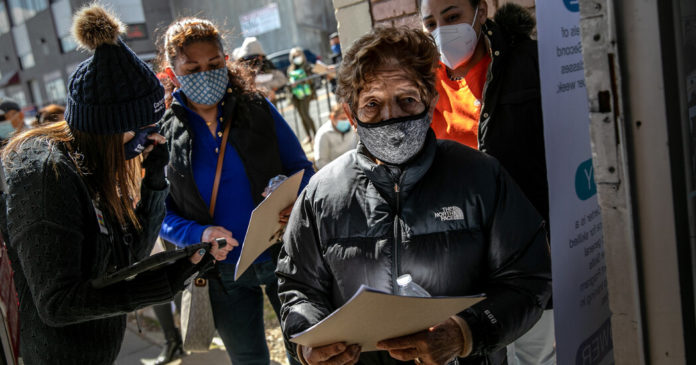In the early weeks of Covid-19 vaccinations, the shining examples of success were all places with politically conservative leaders. Globally, the countries with the largest share of vaccinated people were Britain, Israel and the United Arab Emirates. In the U.S., the states that got off to the fastest starts were Alaska and West Virginia.
This pattern made me wonder whether many progressive-led governments were spending so much effort designing fair-seeming processes that they were failing at the most basic goal of a mass vaccination program: getting shots into arms. That error has held down vaccination rates across much of continental Europe. And it appeared to be an early problem in California and New York.
But it has not turned out to be much of an issue in the U.S. Instead, the states with the highest vaccination rates are now mostly Democratic-leaning, and the states with the lowest rates are deeply conservative.
“The parts of the U.S. that are excelling and those that are struggling with vaccinations are starting to look like the nation’s political map: deeply divided between red and blue states,” Russ Bynum of The Associated Press wrote this week.
Why? There seem to be two main reasons.
1. The party of government
Democrats believe more strongly than Republicans in the power of government. Compare, for example, the chaos of the Trump administration’s virus response to the Biden administration’s. Democrats’ belief in the power of government certainly doesn’t ensure they will manage it competently, but it may improve the odds.
In the most successful state programs, one theme is what you might call centralized simplicity. In Connecticut, Gov. Ned Lamont gave priority to older residents, including people in their 50s, rather than creating an intricate list of medical conditions and job categories that qualified people for shots (and that more privileged families often figure out how to game).
In New Mexico — which has the country’s highest rate of fully vaccinated people, despite also having a high poverty rate — Gov. Michelle Lujan Grisham has overseen the creation of a centralized sign-up system. The state has one vaccine portal that all residents can use to sign up for shots, rather than the piecemeal, confusing systems in many other states, my colleague Simon Romero reports from Albuquerque.
South Dakota, the red state with the highest share of vaccinated residents, has also taken a centralized approach, NPR’s Ailsa Chang points out.
2. Vaccine skepticism
Vaccine hesitancy has declined substantially, polls show. But it is still notably high among registered Republicans.
Hesitancy is also somewhat higher among Black Americans than white or Hispanic Americans — and the south has a large Black population. “Most of the states where vaccination rates are lowest happen to be ones where the Black population is high and where the percentage who graduated from college was low,” CNN’s Harry Enten writes, “while the reverse is true in the states with high vaccination rates.”
Dr. Vernon Rayford, an internal medicine doctor in Tupelo, Miss., told The Times that he had noticed a difference in the sources of skepticism. White skeptics often express a general distrust of government. Black skeptics are particularly mistrustful of the medical system, which has a long history of giving them substandard care — and even outright harmful treatments.
Across much of Mississippi — the state with the smallest share of residents to have received a shot — vaccine appointments are going unfilled largely because of a lack of demand. Two big reasons for the skepticism, Dr. Brian Castrucci, a public health expert, told The Times’s Andrew Jacobs, are misinformation on social media and mixed messages from Republican governors about the urgency of vaccination.
“It’s time to do the heavy lifting needed to overcome the hesitancy we’re encountering,” said Dr. Obie McNair, an internal medicine physician in Jackson.
And the effects?
Vaccine rates still are not high enough — in any state — to have ended the pandemic. In Connecticut and New Mexico, combined, about 11 people have died on a typical recent day. But that toll has fallen more than 80 percent since mid-January, even more than in the rest of the country.
-
Derek Chauvin declined to testify in his trial over the killing of George Floyd. Both sides will make closing arguments on Monday.
-
Officials in Chicago released video of the fatal police shooting of Adam Toledo, 13, last month. Mayor Lori Lightfoot called the footage “excruciating.”
-
A Hong Kong court sentenced several opposition leaders to prison for holding an unauthorized protest. The sentences send a clear message that activism carries severe risks, The Times’s Austin Ramzy writes.
-
Secretary of State Antony Blinken visited Afghanistan to reassure its leaders that the U.S. would continue its support after withdrawing troops.
-
The Dallas Wings selected Charli Collier, a center from the University of Texas, as the No. 1 pick in the W.N.B.A. draft.
Opinions
Can Biden be as transformative as Franklin Roosevelt?
-
Biden “is the first president since Lyndon Johnson who can rightly be called F.D.R.’s heir,” Jonathan Alter writes in The Times.
-
The comparison hinges on Biden’s passing ambitious bills, not just proposing them, The New Yorker’s Susan Glasser says. That will probably require scrapping the filibuster, The New Republic’s Osita Nwanevu writes.
-
Roosevelt started quickly, but later events — like World War II — helped define his presidency. Much of what will define Biden’s hasn’t happened yet, Matthew Continetti argues in National Review.
Morning Reads
Modern Love: A Pakistani Muslim woman knew falling for a Hindu Indian man would break her. And it did.
Lives Lived: Carol Prisant was a 51-year-old former antiques dealer with no journalism experience when she decided she wanted to work for the magazine The World of Interiors. She went on to an illustrious three-decade career. Prisant died at 82.
ARTS AND IDEAS
The long life of Prince Philip
Prince Philip — who died last week at 99, after 73 years as Queen Elizabeth II’s husband and royal consort — will be buried tomorrow in England. The ceremony will be limited to 30 people and will have “minimal fuss,” according to the BBC, which will televise the funeral.
-
Prince Philip was a decorated British World War II veteran. In the 1941 Battle of Cape Matapan off the Greek coast, Philip, then a 19-year-old midshipman, operated the searchlights to find enemy ships.
-
Philip and Elizabeth married in 1947, when he was 26 and she was 21. The pair — who were third cousins — had previously laid eyes on each other when he was 18 and she was 13. Philip was born into the royal families of Denmark and Greece and had royal German relatives, some of whom had supported the Nazis.
-
He was famous for his (often not so subtle) remarks, which people have called oblivious, insensitive or worse. “During his long life in a very public role, it’s hard to think of a group of people he did not offend,” The Washington Post wrote.
-
“The Crown” changed his image. The show displayed him as a vital and complex man who modernized royal life. “It helped humanize him,” a British author told The Times. “And it helps you empathize with him.”
PLAY, WATCH, EAT
What to Cook
Source : Nytimes














